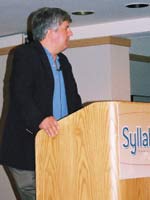A Meeting of Minds
Higher ed IT leaders from across the country spend a day at Syllabus2004 sharing
challenges and visions.
The second annual Executive Summit convened campus technology leadership
from a range of institutions around the nation for a full day of big-picture
thinking. Topics ranged from Course Management Systems, Security, and Privacy,
to Budgeting.
 |
Delivering the results of an exclusive Summit survey of participants is
the first order of business, and opens the meeting. Researcher Mary Fallon
presents her findings, including a ranking of key IT issues and an analysis
of anecdotal interviews completed a few weeks prior to the event. Casey
Green then offers commentary and perspectives from his own Campus Computing
Survey and other current research. |
| There’s always time for informal discussions like this one between University
of Florida associate provost for Distance/Executive/Continuing
Education Bill Riffee, and Casey Green (foreground). Isn’t that how all
the really important work gets done? |
 |
 |
A highly interactive format draws Summit attendees. MIT Assistant
Provost and Director of Academic Computing Vijay Kumar
takes the floating mike, and adds his comments. |
| Two plenary panels fuel debate. “Making the Case: Campus IT Investment
and ROI,” moderated by Bill Riffee, center, is a complex topic taken on
by panelists Brad Wheeler, left, (Indiana University associate
VP for Research and Academic Computing); Ruth Sabean, right, (UCLA
assistant vice provost and director of Educational Technology);
and Rich Pickett, not pictured, (University of San Diego
director of Administrative Services). |
 |
“Keeping the Front Door Unlocked: Security Concerns in the Traditionally
Open Academic Culture,” a panel moderated by ethicist and Carnegie
Mellon (PA) professor of philosophy Robert Cavalier, calls on
the experience of seasoned technologists Ron Danielson, (CIO, Santa
Clara U); Anthony Hill, (CTO, Golden Gate U),
and Kevin Wiggen, CTO and co-founder of Xythos Software.
 |
 |
In ‘musical chairs’ roundtable talks, workgroups of about eight participants
each tackle the hot issues, in depth. Above, MIT senior strategist Phil
Long, left, and Indiana U’s Brad Wheeler, right, lend their
viewpoints to the group, below. |
| More food for thought. After time off and a cocktail reception, participants
relax over dinner and gain yet another perspective from UC-Berkeley
special assistant to the Chancellor for Science and Technology and past
White House technology advisor, Tom Kalil. |
 |
Participants rank this year's issues...
- Course Management Systems (CMS)
- Network Security/ Privacy
- Portal Technologies/ eServices
- Mobile/Wireless/ Broadband
- Budgeting/ Infrastructure Replacement
- ePortfolios/ Student Assessment
- Enterprise Resource Planning (ERP)
- Cost of Content/ Publishing
From the Syllabus2004 Executive Summit Survey Report,
“IT Issues and Strategic Viewpoints in Higher Education,” July 18,
2004.